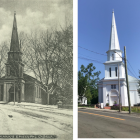News
New Canaan Now & Then: Town Hall
|
New Canaan has had several town halls since it was founded 221 years ago. The current Town Hall is actually the fourth, but only the second one built especially for that purpose.
Although New Canaan was incorporated as a town in 1801, the first town hall was not built until 1825. Until that time, town meetings were held in the Congregational Church, and the clerk’s office and treasury were housed in a business run by Samuel St. John. When St. John passed away in January of 1825, town officials finally felt that they needed a dedicated building out of which to run town business. In the next few months, officials decided to build just north of the Congregational Church on land purchased from Joseph Silliman Jr., the third owner of what is now the Hanford-Silliman House. To fund the purchase of the land and to cover the construction costs, an extra tax of 2.5 cents on the dollar was authorized (on what we assume was property taxes) and four other town owned buildings were sold. The building seemed to serve its purpose very well as it was the seat of government here for the next forty years until the town sold it in 1865. Strangely, upon its sale, the building was moved a few feet from the road and a few feet to the west. The Town House, as it is now called, is located at 13 Oenoke Ridge and it became the home of the New Canaan Museum & Historical Society in 1960.
New Canaan’s second Town Hall was built in 1834 as the first Methodist Church. This small structure was originally located on the north corner of Main Street and Church Street. In 1854, the Methodists sold the building to a group of their parishioners, who had the structure moved up the hill by a team of oxen to its present location of 132-138 Main Street, the current home of Spiga. The new owners then expanded the building into a two story structure so that it could seat 500 people and opened the venue as the Concert Hall, even though lectures were much more common than any musical acts. By 1865, the Concert Hall had gone out of business and the town bought the building for $1,125 despite being in financial trouble due to the Civil War. The first town meeting was held in this building on October 3. (The meeting actually started in the Town House, adjourned, and then reconvened and finished in the second Town Hall.) Even though the building has undergone many changes, it is still the second church structure in New Canaan, after St.





